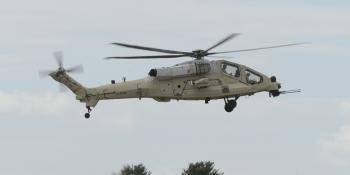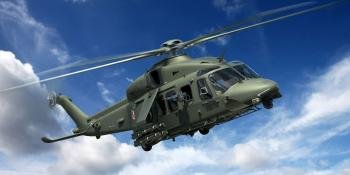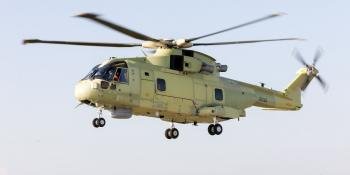Leonardo Helicopters has been quietly developing the AW249 since January 2017, when the firm was awarded a EUR€487m multiyear development contract by the Italian Ministry of Defence (MOD). This deal covers the study, development, industrialisation, production and testing of a new attack helicopter to replace the Italian Army’s ageing AgustaWestland (now Leonardo Helicopters) AW129 Mangusta fleet. As part of the contract – which comes under Italy’s New Exploration and Escort Helicopter (NEES) programme – the company will produce one AW249 prototype, as well as three initial production aircraft.
The Italian Army began operating the AW129 Mangusta in 1990 and is expected to retire the attack helicopter from service from 2025, after what will be more than 35 years of operations. The army has outlined a total requirement for 48 examples of the all-new, technologically advanced AW249 to succeed the aged Mangusta in operational service.
![Italian AW129 Mangusta [US Army/Staff Sgt Teddy Wade]](/sites/keyaero/files/inline-images/926868.jpg)
Italy is not the only nation to have expressed an interest in developing and acquiring the platform. In July 2018, Leonardo signed a letter of intent (LOI) with the state-owned Polish Armaments Group to collaborate on the AW249’s development. Poland is currently in the market to replace the Polish Army’s fleet of Soviet-era Mil Mi-24D/V (NATO reporting name: Hind-D/Hind-E) attack helicopters under the Kruk procurement programme.
Under the LOI, Leonardo and the Polish Armaments Group will explore collaboration opportunities in supporting the design, manufacturing, final assembly, marketing and aftersales of the AW249. If selected by the Polish MOD under the Kruk programme, companies within the Polish Armaments Group, including Leonardo subsidiary, PZL-Swidnik, will take part in the production and servicing of the AW249.
In a press release (issued on July 11, 2018), Leonardo stated that the LOI reinforces a common interest with the Polish Armaments Group for “the development and production of a new combat helicopter… Thanks to this collaboration, Poland’s defence industry will have the unique opportunity to participate in a brand new helicopter development programme, while at the same time contributing to the modernisation plans of the Polish Armed Forces with a new state-of-the-art platform.”
![Mi-24 [Polish MOD]](/sites/keyaero/files/inline-images/10_POLAND_0.jpg)
The Platform
Leonardo describes the AW249 as a technologically advanced attack helicopter that will feature an enhanced performance and high survivability characteristics, combined with low operating costs. Although the platform has been in development for a few years, the company is not yet in a position to reveal more concrete information regarding the platform’s capabilities and systems.
However, the company has so far confirmed that the AW249 will have a maximum take-off weight (MTOW) in the range of 7,000-8,000kg and will have a useful load in excess of 1,800kg. It will be powered by two turboshaft engines, although the specific powerplants have yet to be confirmed. Leonardo states that the aircraft’s powerplants will be capable in operating in both hot and high, and cold weather environmental conditions.
![AW249 [Leonardo Helicopters] #1](/sites/keyaero/files/inline-images/AW249_1.jpg)
When in service, Leonardo outlines that the AW249 will combine high speed and endurance to undertake and support attack, close air support (CAS) and armed escort operations. The platform has also been designed from the outset to have a shipboard operational capability – which will allow the attack helicopter to operate at sea, as well as on land.
The latest technologies will be incorporated into the AW249’s design, which focuses on fitting into a network-centric battlefield. Its open systems architecture provides the platform with a growth capability that will allow it to meet rising and evolving threats for at least the next 30 years. Leonardo adds that the platform will feature both a mission system and battlefield management system that will provide increased situational awareness, enhanced interoperability and manned-unmanned teaming (MUM-T) capabilities.
Including a MUM-T capability will allow the AW249 to ‘team up’ with a number of unmanned aircraft systems (UAS) that act as a force multiplier to enhance lethality, survivability and situational understanding. Having the ability for manned aircraft to team up with unmanned platforms has increasingly become a core requirement in the development of new and existing helicopters and fixed-wing combat aircraft over the last decade.
![AW249 [Leonardo Helicopters]](/sites/keyaero/files/inline-images/AW249_2.jpg)
In terms of munitions, Leonardo has so far confirmed that the AW249 will feature a nose-mounted 20mm rotary cannon and will feature six wing store stations for air-to-air/air-to-ground missiles, guided/unguided rockets and external fuel tanks. The company adds that the “wing stores can carry mixed/asymmetric weapon loads.”
To increase the AW249’s safety characteristics, Leonardo states that the helicopter’s mission system will feature a number of aids to enhance situational awareness and reduce pilot workload. The company boasts that the aircraft will have a high survivability with the inclusion of an advanced integrated defensive aids suite, ballistic tolerance, crashworthiness and low detectability.
Despite not being designed as a stealth platform, the AW249 will incorporate low-observable characteristics, such as a reduced radar cross-section and infrared signature, to make it harder for adversaries to detect. It features a crashworthy airframe, fuel tanks and seats for its two onboard aircrew members. In terms of ballistic tolerance, the helicopter’s critical systems are separated and ballistic tolerant fuel tanks, armoured seats, system redundancy and a dry run capability for the AW249’s drive system have been included.







